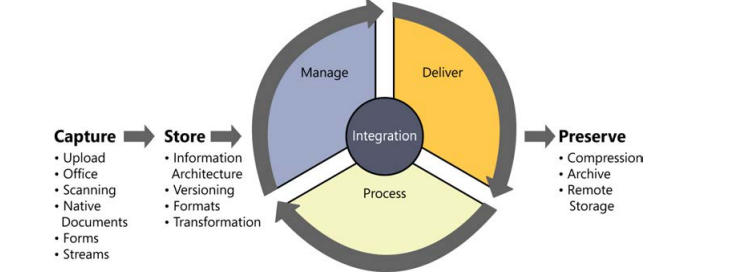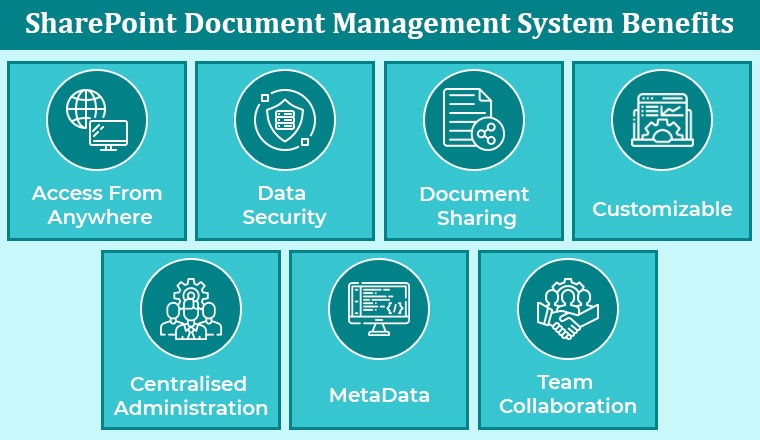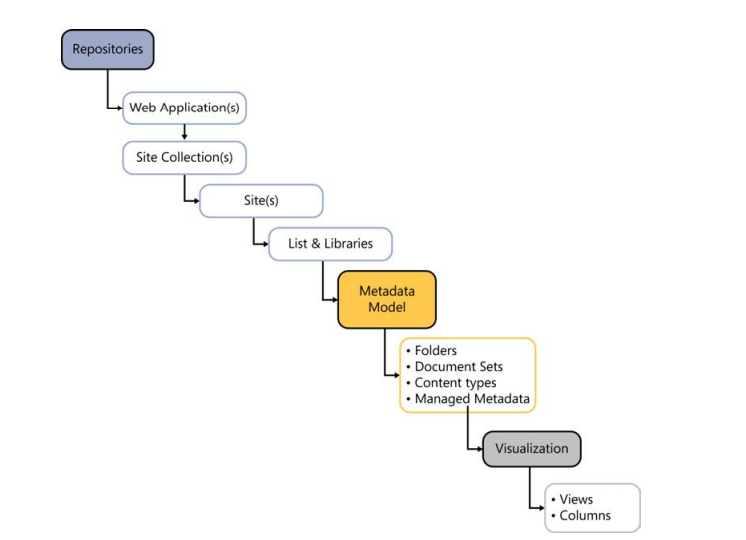SharePoint Enterprise Content Management (ECM) is not a technology, and SharePoint is not an out-of-the-box ECM solution. These two statements contradict what some have thought to be fact and the marketing slicks and PowerPoint presentations so many of us have seen.
ECM is a set of practices, processes, and methodologies that make the technology morph into the most effective previous version controls to store, secure, and consume content. SharePoint is a platform, a grab bag of features and technology that can be molded into a fantastic ECM solution. However, ECM is also not moving what has been done in shared drives to a modern web-based platform. For example, consider how shared drives evolve and how much file duplication and organizational chaos are typically found in shared drives accessed by a community of users.
SharePoint does provide some ECM capabilities for organizations that need them:
- Create lists for different types of content.
- Create folders or libraries based on categories.
- Search for documents within these lists or folders.
- View metadata about each document.
- Manage permissions for other users to access content within those lists or folders.
- Perform bulk actions like deleting entire lists.

What Is The ECM Stack And What Does “Document Life Cycle” Mean?
The ECM stack is a collection of components used to build an ECM solution. It includes all the technologies necessary for an organization to execute its methodologies, including capturing and managing content, storing it in a logical and physical context, delivering it to the right people at the right time, and processing it using the right tools.
The ECM stack is divided into three stages: capture, store, and process. Most knowledge workers consider these to be the least beneficial to their operation, but without them, knowledge workers have nothing to execute. The capture stage includes all processes that make up any given company’s document life cycle; these include internal processes like content management and asset management and external processes like legal compliance regulations.
Here are 5 Advantages Of Using SharePoint For Enterprise Content Management
Encourage The Business Analyst Role To Provide End-To-End Guidance For SharePoint enterprise content management.
When dealing with SharePoint enterprise content management, keeping track of where the money is going is essential. However, the most important part we can accomplish is increasing efficiency and effectiveness in an ECM deployment to ensure that your employees are up on what they need to do to get their work done.
This is why we advise you to develop a new role of Information Architect, which will help guide those responsible for creating, maintaining, and communicating about your ECM solution. An Information Architect works on the end-to-end process of designing, implementing, and using an ECM solution and should be able to guide how best to use it.
It’s also essential to consider the cost of implementing a SharePoint Enterprise Content Management system. This might include employee time spent learning new processes or implementing changes in their workflows. It can also include professional services from consultants or developers who come in after the fact to help ensure everything works smoothly once everyone has been trained on how you should do things differently than before—and sometimes even after training has occurred!

Get Native SharePoint Documents Into Your SharePoint enterprise content management strategy.
The ability to capture SharePoint documents natively in the browser is a powerful tool for end-users, site administrators, and content owners. SharePoint now supports the authoring of documents directly in the browser. This means you can find most of the required functionality in Microsoft Office 365 client applications inside the browser. This makes content capture 90 percent of documents elementary to perform directly in SharePoint.
Native SharePoint documents are those documents created without the use of an external client. Instead, natively running programs on a device (like a smartphone or tablet) are developed specifically for that device platform. Native apps are designed to be used with a specific operating system and may not work correctly on another platform.
For native apps to be published through the Windows Store, they must have no support for other devices or platforms such as Android phones or tablets. Today, this is not the requirement; however, this does not mean that there is the most commonly used form of capture; however, it is the future and the desired method to guide users toward.
Benefits of Content Stream and Enterprise Content Management In SharePoint
SharePoint is a crucial component of a modern enterprise content management (ECM) solution. It has evolved over the past decade to become a flexible and powerful platform for managing any information and data. The broad functions cover many different methods for integrating content capture in SharePoint Online.
The most crucial concept to comprehend is the necessity and governance of such integrations and how it relates to the other forms of capture—for example, surfacing business process management that live in another content system impact how an organization plans their SharePoint enterprise content management environment and train their user experience.
A content stream can come from any electronic source and is defined as the ingestion or publishing of metadata and content via some standard, such as Windows PowerShell, REST, XML, or RSS. An example would be the consumption of news feeds inside a SharePoint page, or the publication of RSS feeds for a list consumed by another system.
Storage Management and the Road to a Strategic ECM Solution
A strategic ECM solution serves your organization’s business process needs, whether in the form of a SharePoint Online-based application or an on-premises solution. For example, a good storage document management strategy means having a well-defined and documented process for ensuring that content is captured, stored, and protected. This way, you can ensure that your organization is prepared for potential problems or disasters.
Storage management also entails ensuring adequate storage space to accommodate your content needs. This includes everything from internal files to external data backups and any media or equipment used by your employees.
You can take what’s inside an individual folder and move it elsewhere or create as many file shares as you want. With SharePoint enterprise content management, we add a solid logical component to file shares called metadata. Metadata is information about the content itself: who created it, when they created it, what they were up to at the time they created it, and all sorts of things that help us understand what kind of information was shared.

Information Architecture For SharePoint enterprise content management
Information Architecture refers to the logical location of content in SharePoint. It is not a specific component, like a folder or site collection, but rather an entire process that can be visualized as a flowchart. Unfortunately, most organizations implement Information Architecture organically, without any clear understanding of its purpose or how you can use it to help users navigate their content.
However, we believe that all organizations should use Information Architecture to visualize all aspects of their enterprise content management solution. We can show that this is the logical location of content in SharePoint.
The trend is moving toward making the repository portion as flat as possible and the metadata portion as comprehensive as possible. For those who strive to be organized, Information Architecture is where it happens. In contrast, using proper metadata in content types instead of folders allows users to slice and dice content on any combinations of information they want.

EPC Group Offers Experienced SharePoint Support Services
SharePoint enterprise content management is a platform that most organizations can utilize to streamline their content, with ECM no exception. Many would argue that ECM through SharePoint is one of its most substantial usages in the enterprise, especially concerning legal and compliance issues. Yet while SharePoint is gaining traction as an ECM solution, only time will tell if it truly becomes the future of content management.
EPC Group is the right choice for your SharePoint support needs and a partner you can trust to provide the best service to your internal team sites. We have over eight years of Microsoft SharePoint experience and have successfully helped thousands of clients adopt this platform. Our technical expertise, responsiveness, and pricing make us the most trusted name in the market today.










